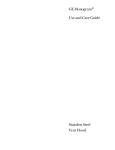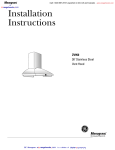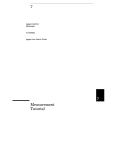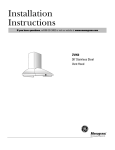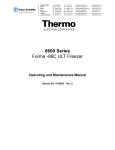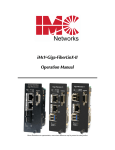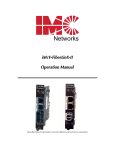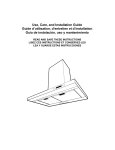Download GE ZV881WSS Kitchen Hood
Transcript
Installation Instructions If you have questions, call 800-GE-CARES or visit our website at: www.monogram.com 30", 36" and 48" Proessional Vent Hoods 48" Wide Models: ZV881, ZV891, ZV880, ZV890 36" Wide Models: ZV671, ZV681, ZV670, ZV680 30" Wide Models: ZV370, ZV371 Monogram. ® We bring good things to life. Installation Preparation BEFORE YOU BEGIN WARNING: Read these instructions completely and carefully. • TO REDUCE THE RISK OF FIRE, ELECTRICAL SHOCK OR INJURY TO PERSONS, OBSERVE THE FOLLOWING: A. Use this unit only in the manner intended by the manufacturer. If you have any questions, contact the manufacturer. B. Before servicing or cleaning unit, switch power off at the service panel and lock service panel to prevent power from being switched on accidentally. If the service panel cannot be locked, fasten a tag or prominent warning label to the panel. IMPORTANT - Save these instructions for local inspector’s use. • IMPORTANT - Observe all governing codes and ordinances. • Note to Installer - Be sure to leave these instructions with the Consumer. • Note to Consumer - Keep these instructions with your Owner’s Manual for future reference. • Skill Level – Installation of this appliance requires basic mechanical and electrical skills. • Completion time – 1 to 3 hours. • Proper installation is the responsibility of the installer. • Product failure due to improper installation is not covered under the Warranty. For general ventilating use only. Do not use to exhaust hazardous or explosive materials or vapors. Structural framing, installation work and electrical wiring must be done by qualified person(s). In accordance with all applicable codes and standards including fire-rated construction. For Monogram local service in your area, 1-800-444-1845. For Monogram service in Canada, call 1-888-880-3030. For Monogram Parts and Accessories, call 1-800-626-2002. Sufficient air is needed for proper combustion and exhausting of gases through the flue (chimney) of fuel burning equipment to prevent back drafting. Follow the heating equipment manufacturer’s guideline and safety standards such as those published by the National Fire Protection Association (NFPA), and the American Society for Heating, Refrigeration and Air Conditioning Engineers (ASHRAE), and the local code authorities. CAUTION: Due to the weight and size of these vent hoods and to reduce the risk of personal injury or damage to the product, TWO PEOPLE ARE REQUIRED FOR PROPER INSTALLATION. READ CAREFULLY. KEEP THESE INSTRUCTIONS. Local codes vary. Installation electrical connections and grounding must comply with applicable codes. In the absence of local codes, the vent should be installed in accordance with National Electrical Code ANSI/NFPA 70-1990 or latest edition. WARNING: To reduce the risk of fire or electrical shock, do not use this range hood with any external solid-state speed control device. Any such alteration from original factory wiring could result in damage to the unit and/ or create an electrical safety hazard. TO REDUCE THE RISK OF FIRE, USE ONLY METAL DUCTWORK. CONTENTS Installation Preparation Models, Duct Covers, Ductwork Accessories ................... 3 Product Dimensions, Product Clearances ...................... 4 Advance Planning ............................................................. 5 Power Supply ................................................................... 5 Duct Fittings ...................................................................... 6 Installation Instructions Tools and Materials Required .......................................... 7 Step 1, Remove Packaging ............................................... 7 Step 2, Check Installation Hardware ............................... 7 Step 3, Determine Accessories, Ductwork and Wiring Locations .............................................................. 8 Step 4, Recommended Wall Mounting Method Wall Framing For Hood Support ........................ 9 Step 5, Install Hood Onto Wall ...................................... 10 Step 6, Alternate Soffit Mounting Method Soffit Framing .................................................. 11 Step 7, Connect Electrical .............................................. 12 Step 8, Connect Ductwork ............................................. 12 Step 9, Reassemble Hood ............................................... 12 Step 10, Install Duct Cover ............................................ 13 Step 11, Install Filters ..................................................... 13 2 Installation Preparation MODELS AVAILABLE 48" Wide Models: ZV881, ZV880 – with tapered sides ZV891, ZV890 – with straight sides These vent hoods are designed to be installed onto a wall. They can be installed beneath a soffit and with duct cover accessories that conceal ductwork. 36" Wide Models: ZV671, ZV670 – with tapered sides ZV681, ZV680 – with straight sides Choose 48" and 36" wide models with straight sides, or models with sides that taper inwards from the bottom to the top. 30" models have straight sides. 30" Wide Models: ZV371, ZV370 – with straight sides DUCT COVER ACCESSORIES Before you begin: Decorative duct covers are available in 6" or 12" heights. The duct covers conceal the ductwork running from the top of the hood to the ceiling or soffit. Before you begin, you should determine the installation height of the hood and order the correct size duct cover. • Order the duct cover accessory at the same time as the vent hood and have on site before installation. Be sure to order the duct cover corresponding to your model. Optional 6" or 12" Duct Cover Optional 6" or 12" Duct Cover Square Shape Duct Covers for Straight Sided Models Oval Shape Duct Covers for Models for Tapered Sided Models Hood Model ZV881 , ZV880 ZV671, ZV670 6” Duct Cover ZX6DC48 ZX6DC36 Dimensions 6”Hx27-3/8”Wx10-1/4”D 6”Hx22-1/2”Wx9-3/16”D Hood Model ZV881, ZV880 ZV671, ZV670 12” Duct Cover ZX12DC48 ZX12DC36 Dimensions 12”Hx27-3/8”Wx10-1/4”D 12”Hx22-1/2”Wx9-3/16”D DUCTWORK ACCESSORIES (for 48" wide models only) Transition duct pieces are available for 48" wide models. These pieces fit over the outlet on top of the hood and will fit into a soffit or can be concealed with a 12" duct cover. Hood Model ZV891, ZV890 ZV681, ZV680 ZV371, ZV370 6” Duct Cover ZX6DC49 ZX6DC38 ZX6DC30 Dimensions 6”Hx47-7/8”Wx12”D 6”Hx35-7/8”Wx12”D 6”Hx29-7/8”Wx12”D Hood Model ZV881, ZV880 ZV681, ZV680 ZV371, ZV370 12” Duct Cover ZX12DC49 ZX12DC38 ZX12DC30 Dimensions 12”Hx47-7/8”Wx12”D 12”Hx35-7/8”Wx12”D 12”Hx29-7/8”Wx12”D 10" 8-3/4" CL 6-5/8" 12" to CL 8-1/4" 18-1/2" 4-1/2" ZX48AY, transition to 10" round for vertical exhaust 3 4-1/2" 18-1/2" ZX48BY, transition to 10" round for horizontal exhaust Installation Preparation 12" PRODUCT DIMENSIONS 35" 18" 12" 47-7/8" 25" 47-7/8" ZV881, ZV880 18" 12" 25" 23" 47-7/8" 18" ZV891, ZV890 35-7/8" 25" 12" 35-7/8" ZV671, ZV670 12" 29-7/8" 18" 18" 35-7/8" 25" 25" ZV681, ZV680 29-7/8" ZV371, ZV370 PRODUCT CLEARANCES These vent hoods must be installed 25" min. to 36” max. above the cooking surface. Installation will be easier if the vent hood is installed before the range or cooktop. The rating plate is located behind the filter cutouts. Remove filters to verify your model number. Soffit Installation Soffit 25" Min. 36" Max. Ceiling Wall Mount Installation Note: Clearances may vary due to type of cooking product and local codes. Check with local inspectors to be sure standard is applicable. 4 25" Min. 36" Max. Installation Preparation ADVANCE PLANNING Ductwork Planning • Determine the exact location of the vent hood. • Plan the route for venting exhaust to the outdoors. • Use the shortest and straightest duct route possible. For satisfactory performance, duct run should not exceed 100 feet equivalent length for any duct configurations. • Refer to “Duct Fittings” chart to compute the maximum permissible length for duct runs to the outdoors. See page 6. • Use metal ductwork. – For 48" models use: 3-1/4" x 24" or 10" round. – For 36" and 30" models: 7" to 10" round or 3-1/4" x 12" to 3-1/4" x 24". • Install a wall or roof cap with damper at the exterior opening. 48" Wide Model Duct Transitions • Transition duct pieces are available for 48" wide models. See illustrations, ZX48BY and ZX48AY transition pieces, page 3. Installation Framing for Adequate Support These vent hoods are heavy. Adequate structural support must be provided. Hoods must be secured to vertical studs in the wall. • Additional studs may be required. • We strongly recommend that the vent hood and duct cover be on site before final framing and wall finishing. This will also help to accurately locate the ductwork and electrical service. Decorative Duct Covers Decorative duct covers are available for all models. The duct covers conceal the ductwork running from the top of the hood to an 8 ft. ceiling or soffit. Duct covers are available in 6" or 12" heights. See page 8 to determine need and size. See page 3 to order exact part number. • To avoid unsightly gaps above the hood, plan the installation height carefully. Determine the size of the wall or roof cap for your model and installation. • Order the caps and any transitions needed in advance. See “Duct and Duct Fittings” listed in your local yellow pages. Be sure to include equivalent lengths of caps and transitions when calculating the total duct run. See “Duct Fittings”, page 6. POWER SUPPLY • Connect the wiring to the house wiring in accordance with local codes. IMPORTANT - (Please read carefully) House wiring location WARNING: • The junction box is located inside the top of the hood. • Electrical connections can be made at the top of the hood or from the inside. • Route house wiring through the ceiling, soffit or back wall as close to the installation location as possible. FOR PERSONAL SAFETY, THIS APPLIANCE MUST BE PROPERLY GROUNDED. Remove house fuse or open circuit breaker before beginning installation. Grounding instructions Do not use an extension cord or adapter plug with this appliance. Follow National electrical codes or prevailing local codes and ordinances. The grounding conductor must be connected to a ground metal, permanent wiring system, or an equipment-grounding terminal or lead on the hood. Electrical supply WARNING: The improper connection of This vent hood must be supplied with 120V, 60Hz, and connected to an individual, properly grounded branch circuit, and protected by a 15 or 20 amp circuit breaker or time delay fuse. • Wiring must be 2 wire with ground. • If the electrical supply does not meet the above requirements, call a licensed electrician before proceeding. the equipment-grounding conductor can result in a risk of electric shock. Check with a qualified electrician or service representative if you are in doubt whether the appliance is properly grounded. 5 Installation Preparation DUCT FITTINGS Duct Piece Use this chart to compute maximum permissable lengths for duct runs to outdoors. Note: Do not exceed maximum permissable equivalent lengths! Maximum duct length: 100 foot for vent hoods. Flexible ducting: If flexible metal ducting is used, all the equivalent feet values in the table should be doubled. The flexible metal duct should be straight and smooth and extended as much as possible. Do NOT use flexible plastic ducting. Note: Any home ventilation system, such as a ventilation hood, may interrupt the proper flow of combustion air and exhaust required by fireplaces, gas furnaces, gas water heaters and other naturally vented systems. To minimize the chance of interruption of such naturally vented systems, follow the heating equipment manufacturer’s guidelines and safety standards such as those published by NFPA and ASHRAE. 48" Hoods Must Use 10" Round Duct or 3-1/4" x 24" Note: Outlet on top of 48" hood is 4-1/2" x 18-1/2". 30" and 36" Hoods May Use 7" to 10" Round, or 3-1/4" x 12" to 3-1/4" x 24" Note: Outlet on top of 36" and 30" hoods is 7" round. Dimensions Equivalent Length* Round, straight 1 ft. (per foot length) 3-1⁄4" x 12" or 3-1/4" x 24" straight 1 ft. (per foot length) 90° elbow 15 ft. 45° elbow 9 ft. 3-1⁄4" x 12" or 3-1/4" x 24" 90° elbow 15 ft. 3-1⁄4" x 12" or 3-1/4" x 24" 45° elbow 9 ft. 3-1⁄4" x 12" or 3-1/4" x 24" 90° flat elbow 20 ft. 7" round to 3-1⁄4" x 12" or 10" round to 3-1/4" x 24" transition 1 ft. 3-1⁄4" x 12" to 7" round or 3-1/4" x 24" to 10" round transition 5 ft. 7" round to 3-1/4" x 12" or 10" round to 3-1/4" x 24" transition 90° elbow 5 ft. Quantity Used 3-1⁄4" x 12" to 7" round or 3-1/4" x 24" to 10" round transition 90° elbow 15 ft. Round wall cap with damper 30 ft. 3-1⁄4" x 12" or 3-1/4" x 24" wall cap with damper 30 ft. Round roof cap 26 ft. Round roof vent 24 ft. * Actual length of straight duct plus duct fitting equivalent. Equivalent length of duct pieces are based on actual tests conducted by GE Evaluation Engineering and reflect requirements for good venting performance with any ventilation hood. 6 Total Duct Run Total Equivalent Length Installation Instructions TOOLS AND MATERIALS REQUIRED (NOT SUPPLIED) • Tape measure • Spirit level • Wire cutter • Wire stripper • Wire nuts • Electric drill and 3/16" bit, 1/2" and 7/16" socket • Torx screwdriver • Hammer • Safety glasses • Gloves to protect against sharp edges • 120V 60Hz. 15 or 20 Amp, 2 wire with ground. Properly grounded branch circuit. • Strain relief • Metal ductwork, length to suit installation. – 3-1/4" x 24" or 10" round for 48" models. – 7" to 10" round or 3-1/4" x 12" to 3-1/4" x 24" for 30" and 36" models. Optional Materials for Mounting: – 47-1/2" x 18" plywood for 48" models – 35-1/2" x 18" plywood for 36" models – 29-1/2" x 18" plywood for 30" models (for tapered hoods, trim to fit) 1 REMOVE PACKAGING AND DISASSEMBLE 2 CHECK INSTALLATION HARDWARE • Remove accessory box from hood crate. • Separate wood crate from pallet. Lift to remove crate. The hood is laying on its back, bolted to the pallet. • Remove tape, packaging, heat lamp(s) and halogen bulbs (if installed). • Locate the hardware accessory box packed with vent hood and check contents. Halogen Bulbs (may be shipped installed) Grease Tray(s) Rear Liner Filter(s) Heat Lamps (may be shipped installed) • Remove 10 screws along the inside top, bottom and both sides. (Fewer screws on some models.) • Lift out rear liner. • Remove hold-down bolts. • Remove and discard pallet. 2 Tinnerman Clips with screws (extra, use if needed) 30" and 36" Models 30" and 36" Models 48" Models 6-1/2" 6-1/2" 3-1/2" 3-1/2" 48" Models 8-7/8" 14-7/8" For 48" Models 14-7/8" 6-1/2" 6-1/2" 8-7/8" For 30" and 36" Models Drill 3/16" Pilot Holes Drill 3/16" Pilot Holes 1-1/2" 1-1/2" Align Edge 24-1/4" to 30-1/4" From Ceiling or 66" to 72" From Floor ✄ ✄ ✄ Cut Along Line Installation Template Six, 5/16" lag screws, 2" long with washers Remove Hold-Down Bolts 7 ✄ Cut Along Line Installation Instructions 3 DETERMINE DUCT COVER ACCESSORIES, DUCTWORK AND WIRING LOCATIONS We recommend that the vent hood and decorative duct cover (if used) be on site before final framing and wall finishing. This will help to accurately locate studs, ductwork and electrical service. Read these instructions to determine the need for duct cover accessories, duct fittings and wiring locations. Centerline To Wall FOR CEILING VENT DUCTING House Wiring Duct Hole Duct Cover Accessories: Perform this step to determine the need and size of an accessory duct cover. These measurements assume a typical 8ft. ceiling height. • Measure down from the ceiling 24-1/4". Measure again to 30-1/4". Use a level to draw a horizontal line at both locations. – 24-1/4" is the total of a 6" duct cover, 18" hood height, plus 1/4" for clearance. – 30-1/4" is the total of a 12" duct cover, 18" hood height, plus 1/4" for clearance. FOR WALL VENT DUCT 30" and 36" Models 30" and 36" Models 48" Models 6-1/2" 8-7/8" 14-7/8" For 48" Models 14-7/8" 6-1/2" 8-7/8" For 30" and 36" Models 6-1/2" • Check the distance from the floor to the horizontal lines. The horizontal lines must fall between 66" and 72" from the floor. • Determine the exact installation location. Use the level to draw the centerline up to the ceiling. • Choose the location height and tape template onto the wall. Be sure the template is straight and level. For Ceiling Heights greater than 8 ft. Add 36" floor to cooktop height, distance from cooking surface to bottom of hood (36" max.) and hood height (18") to determine use of duct covers. 24-1/4" or 30-1/4" 6-1/2" 3-1/2" 3-1/2" 48" Models Centerline 7" or 12" Min. Above Top of Hood Drill 3/16" Pilot Holes Drill 3/16" Pilot Holes 1-1/2" 1-1/2" Align Edge 24-1/4" to 30-1/4" From Ceiling or 66" to 72" From Floor ✄ ✄ Cut Along Line ✄ ✄ Cut Along Line WALL DUCTING: If ductwork will vent to the rear: • Use the level to draw a line straight up from the centerline on the template. 30" and 36" models: • Measure 7" above the top of the hood shown on the template to the centerline of a 7-1/2" dia. duct hole. (Hole may need to be elongated for duct elbow.) 48" wide models: • Measure at least 6-5/8" above the top of the hood shown on the template to the centerline of a 10-1/2" dia. hole duct. Installation below a soffit: Ductwork can be concealed behind the soffit. Duct covers will not needed. Determine Ductwork Locations: CEILING DUCTING: If ductwork will vent straight up to the ceiling: • Use the level to draw the centerline straight up to the ceiling. 30" and 36" models: • For 7" round, measure, 4-3/8" from the back wall to the centerline of a 7-1/2" hole on the ceiling. 48" wide models: • For 10" round duct (using ZX48AY duct transition), measure 6-5/8" from the back wall to the centerline of a 10-1/2" hole. House Wiring Location: • The junction box is located on the top right side of all hood models. • Route house wiring as close to the installation location as possible; through the ceiling, soffit or back wall. Remove the template: • Remove the template and set aside before going to step 4. In the next step you must locate studs or provide additional support for mounting the hood. IMPORTANT: Any transition used must be measured and calculated to determine exact centerline. 8 Installation Instructions 4 Recommended Mounting Method PROVIDE WALL FRAMING FOR HOOD SUPPORT • Mark the exact location of the vent hood as determined in step 3. • Provide mounting support as shown below using METHOD 1 or METHOD 2. IMPORTANT: Framing must be capable of supporting 130 lbs. METHOD 2 7" Min. (30" and 36" Models) 10" Min. (48" Models) Opening for Ductwork METHOD 1 7" Min. (30" and 36" Models) 10" Min. (48" Models) Opening for Ductwork Hood Width Additional Wall Studs Installed To Match Mounting Holes Hood Width Centerline of Installation Space No Additional Wall Studs needed Plywood Sheet (Wall Hole Cutout x Drywall Thickness or 1/2" min.) If drywall is present: • Cut away enough drywall to expose 2 vertical studs. • Install additional wall studs, if needed, spaced to match mounting holes. • Replace drywall. Rear View of Vent Hood (48" Model Shown) Ceiling Drywall If wall studs are exposed: • Cut a sheet of plywood, 18" deep and: – 47-1/2" wide for 48" models, – 35-1/2" wide for 36" models. – 29-1/2" wide for 30" models. For tapered hoods, trim to fit. • Secure the plywood to the studs in at least 2 places. • Tape the template in position along the penciled horizontal line. CHECK TO BE SURE TEMPLATE IS STRAIGHT AND LEVEL. 6" or 12" Duct Cover 6-1/2" Hood Centerline 18" 6-1/2" CL A A 1-1/2" From hood centerline, Dimension A; – 14-7/8" to left and right sides for 48" wide models – 8-7/8" to left and right sides for 36" and 30" models. • Tape the template in position along the penciled horizontal line. CHECK TO BE SURE TEMPLATE IS STRAIGHT AND LEVEL. 9 Installation Instructions 5 INSTALL HOOD ONTO WALL 30" and 36" Models 48" Models Check again to be sure the template is straight and in the exact position. • Select the mounting hole locations indicated for your size model. • Drill six 3/16" pilot holes, 1-1/2" deep into studs or plywood. • Remove the template. • Install lag screws with washers through the two top mounting holes. Do not tighten. • Check level and be sure the bottom of the hood is on the horizontal line. • Install the remaining lag screws with washers through the center and bottom holes. • Tighten all screws. 48" Models 30" and 36" Models 3-1/2" 3-1/2" 8-7/8" For 30" and 36" Models 8-7/8" 6-1/2" 6-1/2" 14-7/8" For 48" Models 14-7/8" 6-1/2" Drill 3/16" Pilot Holes Drill 3/16" Pilot Holes 6-1/2" Align Edge 24-1/4" or 30-1/4" From Ceiling or 66" to 72" From Floor 1-1/2" 1-1/2" ✄ ✄ ALTERNATE MOUNTING TIP: Hanger screws (not supplied) can be used in the top mounting hole locations. Hanger screws will provide support to the hood while nuts and remaining lag screws are being installed. • Install and mount the hood onto the screws. Loosely, install washers and nuts to hold the hood in place. Check level and be sure the bottom of the hood is on the horizontal line. • Secure the hood with the supplied lag screws in remaining 4 holes. Tighten all screws and nuts. ✄ ✄ Cut Along Line Cut Along Line Hanger Screw self-taps (after drilling) into wood. Protruding end has machine thread to accept nut. Also called a table screw. Note: Double nut the screw to drive into wall stud, then remove both nuts before mounting hood. NOTE: For 48" Wide Models During shipping the motor may become loose and need to be tightened. • The motor hangs by a bracket which slips into an opening in the top of the hood. Gently, push the motor up and forward. If you feel movement, use a 1/2" flat blade screwdriver to tighten the barrel nut and secure the motor. Tighten Barrel Nut Lift Motor Forward 10 Installation Instructions 6 Alternate Mounting Method SOFFIT FRAMING FOR HOOD SUPPORT IMPORTANT: Soffit framing must be capable of supporting 130 lbs. SKIP THIS STEP IF USING WALL MOUNTING METHOD IMPORTANT: For additional support and to minimize vibration during operation, we strongly recommend that the hood also be secured to the back wall. • Drive lag screws through the rear panel of the hood and into the wall studs. When necessary, the hood may be installed so that it is supported by the soffit. • The soffit should be constructed with 2 x 4’s. • Determine the installation location. • Mark the centerline of the installation. B Shims “A” “A ” Hood Wid Finished Drywall th 48" Models 30" and 36" Models “A” Centerline to Stud Inner Edge 14-7/8" 8-7/8" • Cut 2 wood shims, 2" x 10" and the same thickness as drywall. Secure shims to the bottom of the horizontal studs, flush with front, as illustrated. NOTE: If drywall is present, cutaway enough to expose studs. “B” Opening Depth or Ductwork 10" Min. 7" Min. • Locate and mark top mounting hole locations. • Drill 3/16" pilot holes through the shims and into the soffit studs. • Hold the hood against the soffit and secure with 6 lag screws and washers. • Add 2 x 4 studs to accept mounting screws (Dim. “A”) at locations shown in the above chart. • Allow minimum openings (Dim. “B”) above the hood to accommodate ductwork. Mounting Hole Locations 48" Hood Ceiling Layout 30" & 36" Hoods Ceiling Layout 14-7/8" 14-7/8" 3" Junction Box 3" 3" 7" 3" 12" 4-3/8" Junction Box 6-1/8" 8-7/8" 12" 10-5/8" 3" Ceiling Cutout 19-1/2" 3" 3" 11-1/2" 6-3/8" 3" 8-7/8" Back Side 5/8" 11 Back Side Installation Instructions 7 CONNECT ELECTRICAL 8 CONNECT DUCTWORK • Cut a length of duct to connect hood flange to the ductwork. • Install ductwork, making connections in the direction of airflow as illustrated. • Secure joints in the ductwork with sheetmetal screws. • Wrap joints with duct tape for airtight seal. Wrap the hood flange with duct tape. Verify that power is turned off at the source. WARNING: If house wiring is not 2-wire with a ground wire, a ground must be provided by the installer. When house wiring is aluminum, be sure to use UL approved anti-oxidant compound and aluminum-tocopper connectors. Electrical connection can be made from the top of the hood or from the inside. • Remove top or inside junction box cover. • Route house wiring to electrical box. • Install strain relief. Duct Tape Over Seam and Screw Air Flow Screw Duct Tape Over Flange Top of Hood Transition duct pieces are available for 48" wide models: – ZX48AY, 4-1/2" x 18-1/2" transition to 10" round, straight-up exhaust. – ZX48BY, 4-1/2" x 18-1/2" transition to 10" round, direct to rear exhaust. Call your GE Dealer to order. Junction Box 9 REASSEMBLE HOOD • Carefully, slide rear panel into installed hood. • Secure the panel with original screws. All screws must be reinstalled. Junction Box • Connect white lead to branch circuit white lead. • Connect black lead to branch circuit black lead. • Connect green lead to branch circuit green or bare ground lead. • Secure all connections with wire nuts on each electrical connector. • Push wires into junction box and replace cover. Check to besure wires are not pinched. Rear Liner • Reinstall heat lamp(s) and Halogen bulb(s). 12 Installation Instructions 10 INSTALL DUCT COVER 11 INSTALL FILTERS Secure With Screws • Place the filter drip tray(s) into the bottom of the opening. (Two trays on 48" models, one tray on 30" and 36" models.) Oval Shape Covers: • Fasten the duct cover to the top of the hood with 3 screws. • Grasp the filter by handles, tip the top portion into the opening, move upwards and drop into drip trays. Square Shape Covers: • Install one side to the top of the hood with 2 screws. Install opposite side piece. • Secure front panel to the side panels with 2 torx screws on each side (provided). 13 Notes 14 Notes 15 Note: While performing installations described in this book, safety glasses or goggles should be worn. TM For Monogram local service in your area, call 1-800-444-1845. Note: Product improvement is a continuing endeavor at General Electric. Therefore, materials, appearance and specifications are subject to change without notice. Pub. No. 49-80094-1 Dwg. No. 164D4290P052 (N.D. 286) 10/01 ® Monogram. General Electric Company Louisville, KY 40225 10657 Rev. 3
















